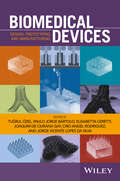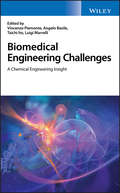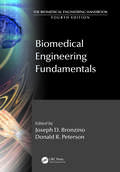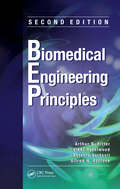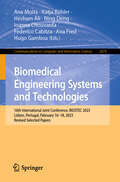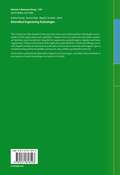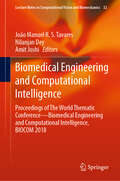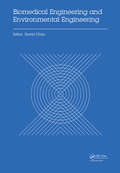- Table View
- List View
Biomedical Devices and Sensors
by Jérôme MolimardMonitoring the human body is a key element of digital health science. Low-cost sensors derived from smartphones or smartwatches may give the impression that sensors are readily available; however, to date, very few of them are actually medical devices. Designing medical devices requires us to undertake a specific approach demanding special skills, as it concerns the integrity of the human body. The process is tightly framed by state regulations in order to ensure compliance with quality assessment, risk management and medical ethics requirements. This book aims to give biomedical students an overview on medical devices design. It firstly gives a historical and economical approach, then develops key elements in medical device design with reference to EU and US regulations, and finally describes sensors for the human body. The clinical approach is presented as the central element in medical device qualification and this offers a perspective on the use of numerical simulation, particularly since its continued growth in the USA; despite the fact that the approach is strictly limited by regulations.
Biomedical Devices: Design, Prototyping, and Manufacturing
by Paolo Jorge Bártolo Elisabetta Ceretti Jorge Vicente Da Silva Tŭgrul Özel Ciro Angel Rodriguez Joaquim De GayBiomedical Devices: Design, Prototyping, and Manufacturing features fundamental discussions of all facets of materials processing and manufacturing processes across a wide range of medical devices and artificial tissues. Represents the first compilation of information on the design, prototyping, and manufacture of medical devices into one volume Offers in-depth coverage of medical devices, beginning with an introductory overview through to the design, manufacture, and applications Features examples of a variety of medical applications of devices, including biopsy micro forceps, micro-needle arrays, wrist implants, spinal spacers, and fixtures Provides students, doctors, scientists, and technicians interested in the development and applications of medical devices the ideal reference source
Biomedical Devices: Materials, Design, and Manufacturing
by Weiqiang Chen Raymond H. LamThis textbook provides essential knowledge for biomedical product development, including material properties, fabrication processes and design techniques for different applications, as well as process design and optimization. This book is multidisciplinary and readers can learn techniques to apply acquired knowledge for various applications of biomedical design. Further, this book encourages readers to discover and convert newly reported technologies into products and services for the future development of biomedical applications. This is an ideal book for upper-level undergraduate and graduate students, engineers, technologists, and researchers working in the area of biomedical engineering and manufacturing.This book also:Provides a comprehensive set of fundamental knowledge for engineering students and entry level engineers to design biomedical devicesOffers a unique approach to manufacturing of biomedical devices by integrating and formulating different considerations in process design tasks into optimization problemsProvides a broad range of application examples to guide readers through the thinking process of designing and manufacturing biomedical devices, from basic understanding about the requirements and regulations to a set of manufacturing parameters
Biomedical Electronics, Noise Shaping ADCs, and Frequency References: Advances in Analog Circuit Design 2022
by Kofi A. A. Makinwa Andrea Baschirotto Pieter HarpeThis book is based on the 18 tutorials presented during the 30th workshop on Advances in Analog Circuit Design. Expert designers present readers with information about a variety of topics at the frontier of analog circuit design, with specific contributions focusing on analog circuits for machine learning, current/voltage/temperature sensors, and high-speed communication via wireless, wireline, or optical links. This book serves as a valuable reference to the state-of-the-art, for anyone involved in analog circuit research and development.
Biomedical Engineering Challenges: A Chemical Engineering Insight
by Luigi Marrelli Angelo Basile Vincenzo Piemonte Taichi ItoAn important resource that puts the focus on the chemical engineering aspects of biomedical engineering In the past 50 years remarkable achievements have been advanced in the fields of biomedical and chemical engineering. With contributions from leading chemical engineers, Biomedical Engineering Challenges reviews the recent research and discovery that sits at the interface of engineering and biology. The authors explore the principles and practices that are applied to the ever-expanding array of such new areas as gene-therapy delivery, biosensor design, and the development of improved therapeutic compounds, imaging agents, and drug delivery vehicles. Filled with illustrative case studies, this important resource examines such important work as methods of growing human cells and tissues outside the body in order to repair or replace damaged tissues. In addition, the text covers a range of topics including the challenges faced with developing artificial lungs, kidneys, and livers; advances in 3D cell culture systems; and chemical reaction methodologies for biomedical imagining analysis. This vital resource: Covers interdisciplinary research at the interface between chemical engineering, biology, and chemistry Provides a series of valuable case studies describing current themes in biomedical engineering Explores chemical engineering principles such as mass transfer, bioreactor technologies as applied to problems such as cell culture, tissue engineering, and biomedical imaging Written from the point of view of chemical engineers, this authoritative guide offers a broad-ranging but concise overview of research at the interface of chemical engineering and biology.
Biomedical Engineering Fundamentals (The Biomedical Engineering Handbook, Fourth Edition)
by Joseph D. Bronzino Donald R. PetersonKnown as the bible of biomedical engineering, The Biomedical Engineering Handbook, Fourth Edition, sets the standard against which all other references of this nature are measured. As such, it has served as a major resource for both skilled professionals and novices to biomedical engineering.Biomedical Engineering Fundamentals, the first volume of
Biomedical Engineering Principles
by Arthur B. Ritter Vikki Hazelwood Antonio Valdevit Alfred N. AscioneCurrent demand in biomedical sciences emphasizes the understanding of basic mechanisms and problem solving rather than rigid empiricism and factual recall. Knowledge of the basic laws of mass and momentum transport as well as model development and validation, biomedical signal processing, biomechanics, and capstone design have indispensable roles i
Biomedical Engineering Science and Technology: Second International Conference, ICBEST 2023, Raipur, India, February 10–11, 2023, Revised Selected Papers (Communications in Computer and Information Science #2003)
by G. R. Sinha Bikesh Kumar Singh Rishikesh PandeyThis CCIS post conference volume constitutes the proceedings of the Second International Conference, ICBEST 2023, in Raipur, India, in February 2023. The 32 full papers together in this volume were carefully reviewed and selected from 60 submissions. The conference's fundamental theme was "Computing in Biomedical Research". They were organized in three tracks as follows: Artificial Intelligence in Healthcare; Computational Mechanics in Healthcare and Health Informatics.
Biomedical Engineering Systems and Technologies: 10th International Joint Conference, Biostec 2017, Porto, Portugal, February 21-23, 2017, Revised Selected Papers (Communications In Computer And Information Science #881)
by Nathalia Peixoto Margarida Silveira Hesham H. Ali Carlos Maciel Egon L. van den BroekThis book constitutes the thoroughly refereed post-conference proceedings of the 10th International Joint Conference on Biomedical Engineering Systems and Technologies, BIOSTEC 2017, held in Porto, Portugal, in February 2017.The 20 revised full papers presented were carefully reviewed and selected from a total of 297 submissions. The papers are organized in topical sections on biomedical electronics and devices; bioimaging; bioinformatics models, methods and algorithms; bio-inspired systems and signal processing; and health informatics.
Biomedical Engineering Systems and Technologies: 11th International Joint Conference, BIOSTEC 2018, Funchal, Madeira, Portugal, January 19–21, 2018, Revised Selected Papers (Communications in Computer and Information Science #1024)
by Paul Anderson Reyer Zwiggelaar Ana Fred Hugo Gamboa Giovanni Saggio Alberto Cliquet Jr. Sheldon Wiebe Sergi Bermúdez i BadiaThis book constitutes the thoroughly refereed post-conference proceedings of the 11th International Joint Conference on Biomedical Engineering Systems and Technologies, BIOSTEC 2018, held in Funchal, Madeira, Portugal, in January 2018.The 25 revised full papers presented were carefully reviewed and selected from a total of 299 submissions. The papers are organized in topical sections on biomedical electronics and devices; bioimaging; bioinformatics models, methods and algorithms; health informatics.
Biomedical Engineering Systems and Technologies: 12th International Joint Conference, BIOSTEC 2019, Prague, Czech Republic, February 22–24, 2019, Revised Selected Papers (Communications in Computer and Information Science #1211)
by Ana Fred Hugo Gamboa Ana Roque Arkadiusz Tomczyk Elisabetta De Maria Felix Putze Roman MoucekThis book constitutes the thoroughly refereed post-conference proceedings of the 12th International Joint Conference on Biomedical Engineering Systems and Technologies, BIOSTEC 2019, held in Prague, Czech Republic, in February 2019.The 22 revised and extended full papers presented were carefully reviewed and selected from a total of 271 submissions. The papers are organized in topical sections on biomedical electronics and devices; bioimaging; bioinformatics models, methods and algorithms; bio-inspired systems and signal processing health informatics.
Biomedical Engineering Systems and Technologies: 13th International Joint Conference, BIOSTEC 2020, Valletta, Malta, February 24–26, 2020, Revised Selected Papers (Communications in Computer and Information Science #1400)
by Ana Fred Hugo Gamboa Federico Cabitza Elisabetta De Maria Xuesong Ye Filipe Soares Pedro Gómez VildaThis book constitutes extended and revised versions of the selected papers from the 13th International Joint Conference on Biomedical Engineering Systems and Technologies, BIOSTEC 2020, held in Valletta, Malta, in February 2020.The 29 revised and extended full papers presented were carefully reviewed and selected from a total of 363 submissions. The papers are organized in topical sections on biomedical electronics and devices; bioimaging; bioinformatics models, methods and algorithms; bio-inspired systems and signal processing; health informatic
Biomedical Engineering Systems and Technologies: 14th International Joint Conference, BIOSTEC 2021, Virtual Event, February 11–13, 2021, Revised Selected Papers (Communications in Computer and Information Science #1710)
by Ana Fred Hugo Gamboa Claudine Gehin Bruno Wacogne Alexandre Douplik Ronny Lorenz Bethany Bracken Cátia PesquitaThis book constitutes the refereed proceedings of the 14th International Joint Conference on Biomedical Engineering Systems and Technologies, BIOSTEC 2021, held virtually due to the COVID-19 crisis, in February 2021. The conference was held virtually due to the COVID-19 crisis.The 13 full papers included in this book were carefully reviewed and selected from 265 submissions. The papers selected to be included in this book contribute to the understanding of relevant trends of current research on Biomedical Engineering Systems and Technologies, including: Pattern Recognition and Machine Learning, Application of Health Informatics in Clinical Cases, Evaluation and Use of Healthcare IT, Medical Signal Acquisition, Analysis and Processing, Data Mining and Data Analysis, Decision Support Systems, e-Health, e-Health Applications, Mobile Technologies for Healthcare Applications and Medical Devices design.
Biomedical Engineering Systems and Technologies: 15th International Joint Conference, BIOSTEC 2022, Virtual Event, February 9–11, 2022, Revised Selected Papers (Communications in Computer and Information Science #1814)
by Ana Fred Hugo Gamboa Ronny Lorenz Athanasios Tsanas Ana Cecília A. Roque Denis Gracanin Nathalie BierThis book constitutes the refereed post-proceedings of the 15th International Conference on Biomedical Engineering Systems and Technologies, BIOSTEC 2022, held as a Virtual Event, during February 9–11, 2022. The 21 full papers included in this book were carefully reviewed and selected from 262 submissions. The papers selected to be included in this book contribute to the understanding of relevant trends of current research on Biomedical Engineering Systems and Technologies, including: Pattern Recognition and Machine Learning, Application of Health Informatics in Clinical Cases, Evaluation and Use of Healthcare IT, Medical Signal Acquisition, Analysis and Processing, Data Mining and Data Analysis, Decision Support Systems, e-Health, e-Health Applications, Mobile Technologies for Healthcare Applications and Medical Devices design.
Biomedical Engineering Systems and Technologies: 16th International Joint Conference, BIOSTEC 2023, Lisbon, Portugal, February 16–18, 2023, Revised Selected Papers (Communications in Computer and Information Science #2079)
by Ana Fred Hugo Gamboa Hesham Ali Ioanna Chouvarda Federico Cabitza Katja Bühler Ana Moita Ning DengThis book constitutes the refereed post-conference proceedings of the 16th International Joint Conference on Biomedical Engineering Systems and Technologies, BIOSTEC 2023, held in Lisbon, Portugal, during February 16-18, 2023. The 7 regular papers included in this book were carefully reviewed and selected from 246 submissions. They contribute to the understanding of relevant trends of current research on Biomedical Engineering Systems and Technologies, that include Pattern Recognition and Machine Learning, Decision Support Systems, Data Mining and Data Analysis, eHealth Applications, eHealth, Detection and Identification, Computational Intelligence, Cognitive Informatics, Big Data in Healthcare and Assistive Technologies.
Biomedical Engineering Systems and Technologies: 6th International Joint Conference, BIOSTEC 2013, Barcelona, Spain, February 11-14, 2013, Revised Selected Papers (Communications in Computer and Information Science #452)
by Jordi Solé-Casals Ana Fred Mireya Fernández-Chimeno Pedro L. Fernandes Sergio Alvarez Deborah Stacey Hugo GamboaThis book constitutes the thoroughly refereed post-conference proceedings of the 6th International Joint Conference on Biomedical Engineering Systems and Technologies, BIOSTEC 2013, held in Barcelona, Spain, in February 2013. The 28 revised full papers presented were carefully reviewed and selected from a total of 392 submissions. The papers cover a wide range of topics and are organized in four general topical sections on biomedical electronics and devices; bioinformatics models, methods and algorithms; bio-inspired systems and signal processing; health informatics.
Biomedical Engineering Systems and Technologies: 7th International Joint Conference, BIOSTEC 2014, Angers, France, March 3-6, 2014, Revised Selected Papers (Communications in Computer and Information Science #511)
by Ana Fred Hugo Gamboa Guy Plantier Tanja SchultzThis book constitutes the thoroughly refereed post-conference proceedings of the 7th International Joint Conference on Biomedical Engineering Systems and Technologies, BIOSTEC 2014, held in Angers, France, in March 2014. The 25 revised full papers presented were carefully reviewed and selected from a total of 362 submissions. The papers cover a wide range of topics and are organized in topical sections on biomedical electronics and devices; bioimaging; bioinformatics models, methods and algorithms; bio-inspired systems and signal processing; health informatics.
Biomedical Engineering Systems and Technologies: 8th International Joint Conference, BIOSTEC 2015, Lisbon, Portugal, January 12-15, 2015, Revised Selected Papers (Communications in Computer and Information Science #574)
by Ana Fred Hugo Gamboa Dirk EliasThis book constitutes the thoroughly refereedpost-conference proceedings of the 8th International Joint Conference onBiomedical Engineering Systems and Technologies, BIOSTEC 2015, held in Lisbon,Portugal, in January 2015. The 27 revised full papers presented together with aninvited paper were carefully reviewed and selected from a total of 375submissions. The papers cover a wide range of topics and are organized in fourgeneral topical sections on biomedical electronics and devices;bioimaging; bioinformatics models,methods and algorithms; bio-inspired systems and signalprocessing; health informatics.
Biomedical Engineering Systems and Technologies: 9th International Joint Conference, BIOSTEC 2016, Rome, Italy, February 21–23, 2016, Revised Selected Papers (Communications in Computer and Information Science #690)
by Ana Fred Hugo GamboaThis book contains the best papers of the First International Joint Conference on B- medical Engineering Systems and Technologies (BIOSTEC 2008), organized by the Institute for Systems and Technologies of Information Control and Communication (INSTICC), technically co-sponsored by the IEEE Engineering in Medicine and Bi- ogy Society (EMB), ACM SIGART and the Workflow Management Coalition (WfMC), in cooperation with AAAI. The purpose of the International Joint Conference on Biomedical Engineering S- tems and Technologies is to bring together researchers and practitioners, including engineers, biologists, health professionals and informatics/computer scientists, int- ested in both theoretical advances and applications of information systems, artificial intelligence, signal processing, electronics and other engineering tools in knowledge areas related to biology and medicine. BIOSTEC is composed of three co-located conferences; each specializes in one of the aforementioned main knowledge areas, namely: * BIODEVICES (International Conference on Biomedical Electronics and - vices) focuses on aspects related to electronics and mechanical engineering, - pecially equipment and materials inspired from biological systems and/or - dressing biological requirements. Monitoring devices, instrumentation sensors and systems, biorobotics, micro-nanotechnologies and biomaterials are some of the technologies addressed at this conference.
Biomedical Engineering Technologies: Volume 1 (Methods in Molecular Biology #2393)
by Avraham Rasooly Houston Baker Miguel R. OssandonThis volume provides detailed technical protocols on current biosensors and imaging technologies and Chapters focus on optical, electrochemical, Quartz crystal microbalance (QCM) biosensors and on medical imaging technologies such as tomography, MRI, and NMR. Written in the format of the highly successful Methods in Molecular Biology series, each chapter includes an introduction to the topic, lists necessary materials and reagents, includes tips on troubleshooting and known pitfalls, and step-by-step, readily reproducible protocols. Authoritative and practical, Biomedical Engineering Technologies, Volume 1 provides technical details in descriptions of major technologies by experts in the field.
Biomedical Engineering Technologies: Volume 2 (Methods in Molecular Biology #2394)
by Avraham Rasooly Houston Baker Miguel R. OssandonThis volume provides detailed technical protocols on current biomedical technologies and examples of their applications and capabilities. Chapters focus on molecular and cellular analytical methods, experimental new drug delivery approaches, guided surgery, implants and tissue engineering. Written in the format of the highly successful Methods in Molecular Biology series, each chapter includes an introduction to the topic, lists necessary materials and reagents, tips on troubleshooting and known pitfalls, and step-by-step, readily reproducible protocols. Authoritative and practical, Biomedical Engineering Technologies, Volume 2 provides technical details in descriptions of major technologies by experts in the field.
Biomedical Engineering and Computational Intelligence: Proceedings of The World Thematic Conference—Biomedical Engineering and Computational Intelligence, BIOCOM 2018 (Lecture Notes in Computational Vision and Biomechanics #32)
by João Manuel R. S. Tavares Nilanjan Dey Amit JoshiThis book reports on timely research at the interface between biomedical engineering and intelligence technologies applied to biology and healthcare. It covers cutting-edge methods applied to biomechanics and robotics, EEG time series analysis, blood glucose prediction models, among others. It includes ten chapters, which were selected upon a rigorous peer-review process and presented at the 1st World Thematic Conference - Biomedical Engineering and Computational Intelligence, BIOCOM 2018, held in London, United Kingdom, during October 30–31, 2018.
Biomedical Engineering and Environmental Engineering: Proceedings of the 2014 2nd International Conference on Biomedical Engineering and Environmental Engineering (ICBEEE 2014), December 24-25, 2014, Wuhan, China
by David ChanThis conference series is a forum for enhancing mutual understanding between Biomedical Engineering and Environmental Engineering field. This proceeding provides contributions from many experts representing industry and academic establishments worldwide. The researchers are from different countries and professional. The conference brought 
Biomedical Engineering and Neuroscience: Proceedings Of The 3rd International Scientific Conference On Brain-computer Interfaces, Bci 2018, March 13-14, Opole, Poland (Advances In Intelligent Systems And Computing #720)
by Wojciech P. Hunek Szczepan PaszkielThis edition of the volume ‘Advances in Intelligent Systems and Computing’ presents the proceedings of the 3rd International Scientific Conference BCI. The event was held at Opole University of Technology in Poland on 13 and 14 March 2018. Since 2014 the conference has taken place every two years at the University’s Faculty of Electrical Engineering, Automatic Control and Informatics. The conference focused on the issues relating to new trends in modern brain–computer interfaces (BCI) and control engineering, including neurobiology–neurosurgery, cognitive science–bioethics, biophysics–biochemistry, modeling–neuroinformatics, BCI technology, biomedical engineering, control and robotics, computer engineering and neurorehabilitation–biofeedback.In addition to paper presentations, the scientific program also included a number of practical demonstrations covering, for example, the on-line control of mobile robot and unmanned aerial vehicle using the BCI technology.
Biomedical Engineering and its Applications in Healthcare
by Sudip PaulThis book illustrates the significance of biomedical engineering in modern healthcare systems. Biomedical engineering plays an important role in a range of areas, from diagnosis and analysis to treatment and recovery and has entered the public consciousness through the proliferation of implantable medical devices, such as pacemakers and artificial hips, as well as the more futuristic technologies such as stem cell engineering and 3-D printing of biological organs. Starting with an introduction to biomedical engineering, the book then discusses various tools and techniques for medical diagnostics and treatment and recent advances. It also provides comprehensive and integrated information on rehabilitation engineering, including the design of artificial body parts, and the underlying principles, and standards. It also presents a conceptual framework to clarify the relationship between ethical policies in medical practice and philosophical moral reasoning. Lastly, the book highlights a number of challenges associated with modern healthcare technologies.

